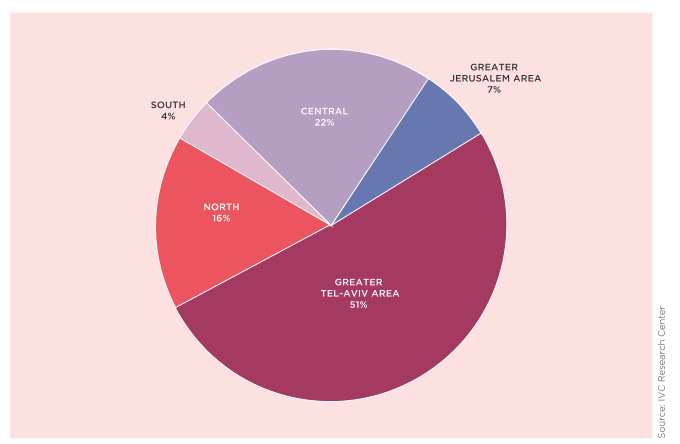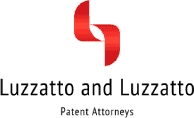


In recent years we have witnessed a turning point in the development of the Negev. The essence of the change is to replicate Israel's successful high-tech model, which operates almost entirely in the center of the country, to the developing periphery.
Although the Negev (the southern part of Israel) controls 60% of the country's territory, its economic activity is low compared to the center of the country. In this sense, the Negev is no different from other parts of the country that are defined as "peripheral", all of which are inferior to the center of the country, and especially the city of Tel-Aviv, which serves as the center for most of the country's economic, technological and technological activities.
It should be noted that a study conducted in the past showed that per capita, GDP in Tel-Aviv is three times higher than the average GDP in the entire country. Although only 5.2% of the country's population lives in the city, 15.2% of the employees are employed in Tel-Aviv, and 16.7% of the Israeli GDP comes from it.
One cannot, of course, be indifferent to these figures, since in many ways Tel-Aviv derives its power from Israel, and if we treat the economic resources of Israeli society as a zero-sum game, strengthening the Israeli economy involves shifting economic power from Tel Aviv. To this we must add the vision of the flowering of the Negev that was outlined by the first prime minister, David Ben-Gurion, who saw the Negev as the focus of Israel's future industrial-scientific development.
In recent years, however, we have witnessed a turning point in the development of the Negev. One of the most important decisions made by the government in this context was the decision to relocate IDF bases to the Negev, with an emphasis on the IDF's elite technological units.
The rationale behind the project, which is one of the most important ever for the future of the Negev, is twofold: to transform the entire Negev region into an attractive area and to contribute to the building of the IDF's strength.
The assumption is that the moving of units and bases to the Negev will lead to tremendous regional development – it will expand infrastructure build-up, railway lines and roads will be paved, and new education and health institutions will be built.
Above all, the relocation of the IDF's high-tech technological units is of great importance to the continued consolidation of the technological ecosystem that has been created in the Negev. Such ecosystem combines military-civilian R & D, advanced industry and human capital with a synergetic connection to the research and teaching infrastructure of Ben-Gurion University and the high-tech centers that are developing in high-tech parks in Be'er Sheva and Omer, all of which are supposed to bring about dramatic change in the Negev and create a tremendous momentum for attracting capital investments to the Negev.
In fact, the Negev is facing one of the most significant periods in its history since the establishment of the State of Israel. The transfer of IDF bases to the south creates unprecedented economic, social and environmental opportunities for the region, and has never invested so much in infrastructure in the Negev.
The Negev – The New Tiger
The relocation of the IDF bases to the Negev includes a number of moves, some of which have already been implemented and the others are in the process of being implemented: the transfer of the Air Force's transport base from Lod to the new Nevatim base in the Negev, the establishment of the IDF Training Base near Yeruham, the construction of the intelligence center (near Omer), the construction of the telecommunication center (near the high-tech park in Be'er Sheva) and the relocation of the headquarters of the Southern Command (also to a high-tech park in Be'er Sheva).
The telecommunication center, for example, whose construction will begin soon, is no less than a mega project. In the area of the high-tech park in Be'er Sheva, 140,000 square meters will be built on an area of 180 dunams, which will serve more than 5,000 soldiers, of whom 1,200 will be permanent soldiers. The base will be built in eight-story buildings and will operate in the form of a "Smart City" that creates its own power and energy.
The momentum given by these projects to the Negev is felt in full force. A large portion of the work was done by local contractors and most of the equipment was supplied by local suppliers. The IDF's move to the Negev is expected to increase the economic activity in the Negev by a rate of one and a half billion shekels per year and the growth potential in the second decade can reach up to NIS 2.3 billion. Moreover, in the coming decade more than NIS 48 billion will be invested in a variety of infrastructures in the Negev. Apart from the IDF bases, there are roads, railroads, interchanges and industrial parks, and the 8,000 people in the Negev are expected to settle in the Negev within a decade.
The center of regional development is the city of Be'er Sheva and her satellite cities in the Negev, which change the region beyond recognition and enjoy unprecedented building momentum, along with the establishment of many cultural, educational and entertainment centers.
It is important to emphasize that this development relies almost exclusively on high technology, with the aim of establishing long-term sustainable growth anchors in the Negev. This is a dramatic change in the area that until a few years ago was outside the investment and development map in Israel, certainly in terms of venture capital investments (only 4% of hi-tech companies were in the south).
In fact, Israeli high-tech is characterized by a clear geographical-demographic concentration. Within a radius of 20-30 km in the center of the country, most of the Israeli technological industry is concentrated, about 73%, including all its auxiliary interfaces – venture capital funds, law firms and accountants, consultants, economists, etc. About the luxury restaurants.
The data are instructive – 51% of the companies operate in Greater Tel- Aviv, 22% of the companies operate in the central region, including Herzliya Pituah, and the remainder is divided between Jerusalem, the northern region and the southern region.
To strengthen the technological ecosystem in the Negev
As mentioned above, the change taking place in the Negev today is anchored in a strategic vision according to which the development of the region will be based on the security-technological-industrial synergy. This change is already taking place before our eyes. Take for example the new high-tech park in Be'er Sheva and the existing park in Omer (a nearby settlement). Side by side are high-tech companies that are connected to Ben-Gurion University's research institutes and to the Sammy Shimon Technology College. Together, they meet the technological needs of the army, which simultaneously consumes technologies and sources of technologies and technological human capital.
In fact, high-tech parks, both in Omer and Be'er Sheva, were set up deliberately near the university, in order to strengthen the technological ecosystem in the Negev. This is based on a strong links between industry and academia, on the way to commercial R & D applications, and the connection between the IDF and academia, all of which attracts local and multinational high-tech companies to the Negev, while creating quality sources of employment, and more.
Already with the establishment of the National Cyber Center in the Negev and the entry into the park of multi-national technology companies such as Ness, RAD and EMC, Be'er Sheva is a magnet for leading high-tech and biotech companies from Israel and around the world, as well as many start-ups.
Here, too, the government played an important role. The government decided to grant companies operating from the Cyber Campus a tax benefit of 20% of the salaries of their employees.
There are already results on the ground. About 3 years ago, the Brandeis International Business School and the consulting firm T3 published a study that gained considerable exposure in the foreign media, and in which Be'er Sheva was ranked first among the seven cities evaluated by the organizations as the most important high-tech cities in the world.
This is the essence of the change – to replicate Israel's successful high-tech model, which operates almost entirely in the center of the country, to the developing periphery.
In the last 25 years, the Israeli high-tech industry has become a leading innovation center around the world, preventing the economy from growing. Israel is considered a fertile ground for the growth of start-ups and the development of innovative technologies. The high-tech industry has a significant contribution to the Israeli economy: it employs about 9% of all employees, produces 16% of the total business product, and exports about 43% of total manufacturing exports. This industry is based on technological innovation and is the main engine for growth, economic prosperity and productivity growth in all sectors of the economy. But this prosperity is the property of the central region only and now it is time to reproduce it to the periphery as well.
Encouraging high-tech companies to move to the Negev will achieve several goals at the same time: it will create new economic anchors in the south (each high-tech job means 2.5 additional workers in auxiliary industries and auxiliary services) is a qualitative population flow and purchasing power to the Negev, will encourage further growth, and it will increase the receipts of cities and local authorities in the area from the payment of municipal taxes and various local taxes.
Most important of all is the new spirit that will follow these companies to the Negev – a new spirit of entrepreneurship, innovation and momentum – which will meet in the cities and communities a young and educated population that is eager to integrate into the cyber industry.
Despite the concern about the use of recycled clichés, the Negev has all the elements needed to imitate not only the center of the country but the Silicon Valley model. California's Silicon Valley has developed thanks to the infrastructure laid down by the US military and NASA, which has been involved in research development at Stanford University. All these were the nucleus attracted by thousands of large high-tech companies that nurtured the creation of a unique eco-system.
A critical mass in the development of the Negev
The Israeli technological ecosystem, nurtured by the unique connection between academia, industry and the army, which has succeeded in bringing about the relative advantages of the Israeli economy, can flourish in the Negev. The successful combination of the army's human and technological capital infrastructures, outstanding academia, international companies and Israeli start-ups make the Negev a tiger that races ahead and joins global markets.
The relocation of the IDF bases to the south has already created a critical mass in the development of the Negev, and it is now left to hope that, as a result of economic development, new populations will flow here, which will bring new blood to the region. In the center and in Sharon, with an emphasis on the future triangle – Rothschild-Herzliya – and now also get used to a new center – the Negev.
However, in order to complete the historic process, more investment is needed in improving the social systems in the region – education, health and employment – in order to create a suitable living and living environment for the benefit of the residents of the region.
Special emphasis should be placed on solving the Bedouin problem in the Negev. The solutions exist, reports have been written and plans have been created and now the application is left to access. This should be done in cooperation with representatives of the Diaspora and beautiful one hour earlier. It's a social time bomb that, if not dealt with, will explode all of us inside.
This is one of the greatest challenges we have ever known, but also a tremendous opportunity to bring about appropriate social change and to shift the Israeli center of gravity from the crowded Dan region to the periphery. The social protest emphasizes the need for housing solutions and the creation of new economic opportunities for the younger generation. The Negev can provide a good answer to these needs and become the focus of Israel's new development.
The road to narrowing the gaps between the center and the periphery is still far away. The timing is crucial in view of the transfer of IDF camps to the Negev, which can serve as a lever for a dramatic change in the economy of the region. The concentration of technological power in Greater Tel Aviv intensifies existing socio-economic gaps in Israeli society, and therefore the government must act actively to decentralize the industry in other areas outside the "State of Tel Aviv".


Relevant Articles
Regarding Patent Term Extensions in Israel
